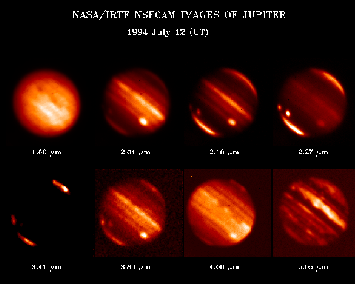

NOTE: Click on the image to view it at its highest resolution.
Image from the NASA/IRTF using the near-infrared 256*256 array camera, NSFCAM.
This July 17 set shows the affect of the comet impacts on the atmosphere. At wavelengths which allow one to peer deep in the atmosphere (such as 1.6 um and 4.0), not much affect is seen. However, at wavelengths which restrict deep-atmosphere viewing, the impact sites are more and more prominent, in a relative sense to other features such as the Great Red Spot (near the right hand side of these images). Two impact sites are seen near the western limb. Impact Site A is the one nearest the center (left of center), here seen having just completed its first Jovian "day" or rotation after the impact of the A fragment some 12 hours earlier. Impact Site C, here seen just one hour after impact, is near the limb. In most absorption bands (such as 2.27 um), Impact site C is dimmer than A, indicating that it has less reflective clouds. However, it is quite prominent in the deepest absorption bands (such as 3.4 um), probably indicating a higher altitude cloudtop than for A,at this time. However, its strong prominence in both 3.4 and 3.8-um pictures may indicate other effects (such as thermal or auroral emission).
Submitted by Kevin H. Baines for the NASA IRTF Comet Science Team.